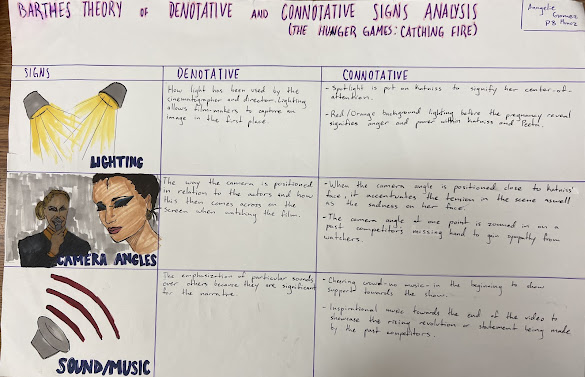The objective of this assignment was to select 3 visual signs from "The Hunger Games Catching Fire" movie clip provided (https://www.youtube.com/watch?v=dM1ABOZQ8Po). We were to analyze and document the denotative meaning for each of the signs selected as well as write two connotative meanings for each with the following parameters:
-emotional overtones
-objective interpretation
-social values
-media consumption experience
-ideological assumptions.
The first sign I chose was lighting, since it really stuck out to me while watching the clip.-objective interpretation
-social values
-media consumption experience
-ideological assumptions.
The denotative meaning of lighting is how light is used by the cinematographer and director. Lighting allows filmmakers to capture an image in the first place.
Connotative signs are:
-The almost blinding spotlight is put on Katniss to accentuate her center-of-attention to the crowd but nervousness to the viewers.
-Red/Orange background lighting before the pregnancy reveal signifies the anger and power within Katniss and Peeta.
The second sign I chose was camera angles. The denotative meaning of camera angles is the way the camera is positioned in relation to the actors and how this then comes across on the screen when watching the film.
Connotative signs are:
-When the camera angle is positioned close to Katniss' face, it accentuates the tension in the scene as well as the sadness on her face.
-The camera angle at one point is zoomed in on a past competitors missing hand to gain sympathy from viewers.
The third sign I chose was sound/music. The denotative meaning of sound/music is the emphasizing of particular sounds over others because they are significant for the narrative.
Connotative signs are:
-Cheering crowd with no music in the beginning to show the crowd's support for the showcase.
-Inspirational music towards the end of the video to showcase the rising revolution or statement being made by the Katniss, Peeta, and past competitors.
What did I learn?
This assignment has taught me how to better analyze film from different perspectives. Analyzing signs of a movie clip through connotative and denotative means is a lot harder than analyzing still drawings since different factors like lighting and sound come in to play. This assignment proved to be harder than the last preliminary exercise but was a lot more interesting and overall enjoyable.






